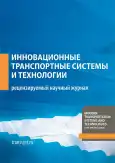Electronic differential system based on neural networks for electric vehicles: development, adaptation and prospects of application
- 作者: Lisov A.A.1, Vozmilov A.G.1
-
隶属关系:
- South Ural State University
- 期: 卷 11, 编号 1 (2025)
- 页面: 24-42
- 栏目: Original studies
- URL: https://bakhtiniada.ru/transj/article/view/289342
- DOI: https://doi.org/10.17816/transsyst659809
- ID: 289342
如何引用文章
全文:
详细
Aim. The analysis of possibilities and prospects of development of an electronic differential system for electric vehicles based on artificial neural networks.
Materials and Methods. We discuss the key advantages of the proposed system, such as its customization capability to various vehicle designs, integration of additional sensors, support for self-driving mode and the ability to interact with the ABS system.
Results. We considered the ways to improve the model, including the introduction of self-learning algorithms, optimization of inverter circuits for controlling multiple motors, and implementation of all-wheel drive configurations. In addition, we discuss the customization of the electronic differential system for operation on low-power devices using quantization, pruning and architecture simplification methods.
Conclusion. The proposed approaches and algorithms have the potential for widespread deployment in the electric vehicle industry, opening new vistas for development of intelligent vehicle control systems.
作者简介
Andrey Lisov
South Ural State University
编辑信件的主要联系方式.
Email: lisov.andrey2013@yandex.ru
ORCID iD: 0000-0001-7282-8470
SPIN 代码: 1956-3662
postgraduate student
俄罗斯联邦, ChelyabinskAlexander Vozmilov
South Ural State University
Email: vozmiag@rambler.ru
ORCID iD: 0000-0002-1292-3975
SPIN 代码: 2893-8730
Professor, Doctor of Technical Sciences
俄罗斯联邦, Chelyabinsk参考
- Lisov AA. Development of an electronic differential system for electric vehicles based on deep neural network. Modern Transportation Systems and Technologies. 2024;10(3):351–367. (in Russ.) doi: 10.17816/transsyst634127
- Lisov AA, Panishev SA, Gundarev KA. Development of an Electronic Differential System Based on Artificial Neural Networks for Electric Transport. In: 2024 International Ural Conference on Electrical Power Engineering (UralCon). 2024;192–196. doi: 10.1109/UralCon62137.2024.10718938
- Yildirim M, Kurum H. Electronic differential system for an electric vehicle with four in-wheel PMSM. In: Proceedings of the 2020 IEEE 91st Vehicular Technology Conference (VTC2020-Spring). 2020;1–5. doi: 10.1109/VTC2020-Spring48590.2020.9129139
- Vozmilov AG, Urmanov VG, Lisov AA, Ilimbetov RYu. Development and simulation of the proportional and integral regulator for the electronic differential of an electric farm tractor. Bulletin of the Bashkir State Agrarian University. 2022;2(62):119–124 (In Russ.). doi: 10.31563/1684-7628-2022-62-2-119-124
- Rigas ES, Ramchurn SD, Bassiliades N. Managing electric vehicles in the smart grid using artificial intelligence: A survey. IEEE Transactions on Intelligent Transportation Systems. 2014;16(4):1619–1635. doi: 10.1109/TITS.2014.2376873
- Nguyen DH, Widrow B. Neural networks for self-learning control systems. IEEE Control Systems Magazine. 2002;10(3):18–23. doi: 10.1109/37.55119
- Li SE. Deep reinforcement learning. In: Reinforcement Learning for Sequential Decision and Optimal Control. Singapore: Springer Nature Singapore. 2023:365–402. doi: 10.1007/978-981-19-7784-8_10
- Hizume M. Independent vector control of parallel-connected two induction motors by a five-leg inverter. In: Proceedings of the 10th European Conference on Power Electronics and Applications. 2003;778.
- Nozawa Y. Independent position control of two permanent magnet synchronous motors with five-leg inverter by the expanded two arm modulation method. JIASC. 2005;79.
- Oka K. Improved method of voltage transfer ratio for five-leg inverter. JIASC2005. 2005;75.
- Gulbudak O, Gokdag M. Dual-hysteresis band control of nine-switch inverter to control two induction motors. IEEE Transactions on Energy Conversion. 2021;37(2):788–99. doi: 10.1109/TEC.2021.3131385
- Krishnakumar V, Kamaraj V, Perianayagam CA. An integrated drive for two PMSMs involved automotive applications and development of current reference expanded two arm modulation technique. Circuits and Systems. 2016;7(08):1794–1799. doi: 10.4236/cs.2016.78155
- Pao YH, Phillips SM. The functional link net and learning optimal control. Neurocomputing. 1995;9:149–164. doi: 10.1016/0925-2312(95)00066-F
- Radunovic B, Le Boudec JY. A unified framework for max-min and min-max fairness with applications. IEEE/ACM Transactions on networking. 2007;15(5):1073–1083. doi: 10.1109/TNET.2007.896231
- Razaviyayn M, Huang T, Lu S, Nouiehed M, Sanjabi M, Hong M. Nonconvex min-max optimization: Applications, challenges, and recent theoretical advances. IEEE Signal Processing Magazine. 2020;37(5):55–66. doi: 10.1109/MSP.2020.3003851
- Kim N, Bae J, Kim C, et al. Object distance estimation using a single image taken from a moving rolling shutter camera. Sensors. 2020;20(14):3860–3870. doi: 10.3390/s20143860
- Zhu W, Anderson B, Zhu S, Wang YA. computer vision-based system for stride length estimation using a mobile phone camera. In: 18th International ACM SIGACCESS Conference on Computers and Accessibility. 2016:121–130. doi: 10.1145/2982142.298215
- Gholami A, Kim S, Dong Z, et al. A survey of quantization methods for efficient neural network inference. Low-Power Computer Vision. 2022:291–326.
- Guo Y. A survey on methods and theories of quantized neural networks. arXiv preprint arXiv:1808.04752. 2018. doi: 10.48550/arXiv.1808.04752
- Blalock D, Gonzalez Ortiz JJ, Frankle J, Guttag J. What is the state of neural network pruning? Proceedings of machine learning and systems. 2020;2:129–146.
- Cheng H, Zhang M, Shi JQ. A survey on deep neural network pruning: Taxonomy, comparison, analysis, and recommendations. IEEE Transactions on Pattern Analysis and Machine Intelligence. 2024. doi: 10.1109/TPAMI.2024.3447085
- Cheng Y, Wang D, Zhou P, Zhang T. Model compression and acceleration for deep neural networks: The principles, progress, and challenges. IEEE Signal Processing Magazine. 2018;35(1):126–36. doi: 10.1109/MSP.2017.2765695
- Deng L, Li G, Han S, et al. Model compression and hardware acceleration for neural networks: A comprehensive survey. Proceedings of the IEEE. 2020;108(4):485–532. doi: 10.1109/JPROC.2020.2976475
- Burgueno L, Cabot J, Li S, Gérard S. A generic LSTM neural network architecture to infer heterogeneous model transformations. Software and Systems Modeling. 2022;21(1):139–156. doi: 10.1007/s10270-021-00893-y
- Burgueno L, Cabot J, Li S, Gérard S. An LSTM-based neural network architecture for model transformations. ACM/IEEE 22nd International Conference on Model Driven Engineering Languages and Systems (MODELS). 2019:294–299. doi: 10.1016/j.cola.2022.101174
- Bulat A, Kossaifi J, Tzimiropoulos G, Pantic M. Matrix and tensor decompositions for training binary neural networks. arXiv preprint arXiv:1904.07852. 2019. doi: 10.48550/arXiv.1904.07852
- Chen S, Zhou J, Sun W, Huang L. Joint matrix decomposition for deep convolutional neural networks compression. Neurocomputing. 2023;516:11–26. doi: 10.1016/j.neucom.2022.10.021
- Capra M, Bussolino B, Marchisio A, et al. Hardware and software optimizations for accelerating deep neural networks: Survey of current trends, challenges, and the road ahead. IEEE Access. 2020;8:225134–225180. doi: 10.1109/ACCESS.2020.3039858
补充文件















